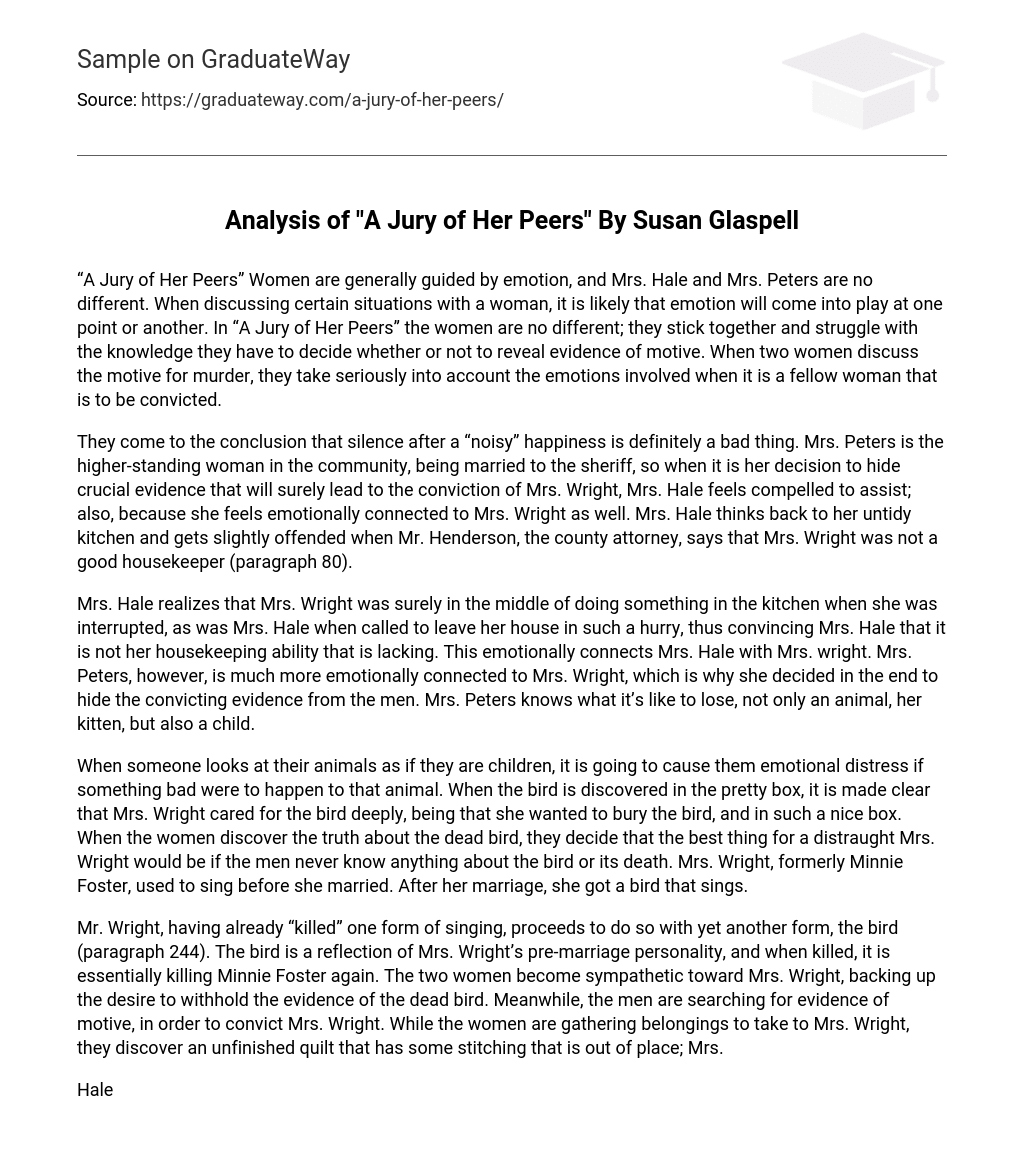In “A Jury of Her Peers,” Mrs. Hale and Mrs. Peters, like most women, are guided by emotion. When discussing a particular situation with another woman, it is expected that emotions will be involved. These women in the story unite and confront the dilemma of whether or not to disclose evidence relating to motive. They understand the significance of considering the emotions at stake, particularly when it involves convicting another woman for murder.
After realizing that silence following a joyful uproar is unquestionably negative, they agree that it is wrong for Mrs. Peters, who holds a higher social position due to her marriage to the sheriff, to conceal vital evidence that could undoubtedly secure Mrs. Wright’s conviction. Mrs. Hale, feeling an emotional bond with Mrs. Wright and compelled to help, recalls her own messy kitchen and takes offense when the county attorney, Mr. Henderson, remarks that Mrs. Wright was not skilled at housekeeping (paragraph 80).
Mrs. Hale realizes that Mrs. Wright was interrupted while doing something in the kitchen, just like Mrs. Hale herself when she had to leave her house quickly. This convinces Mrs. Hale that her housekeeping ability is not to blame. This emotional connection between Mrs. Hale and Mrs. Wright is strong. However, Mrs. Peters feels an even stronger emotional connection to Mrs. Wright. That’s why she ultimately decides to hide the evidence that could convict Mrs. Wright from the men. Mrs. Peters has experienced loss before, both in the form of losing her kitten and losing a child.
When one regards their animals as if they are their own children, any harm inflicted upon these animals can be extremely distressing. The significance of Mrs. Wright’s affection for the bird becomes evident when it is found in a beautiful box, showing just how deeply she cared for it. Upon uncovering the truth about the bird’s demise, the women decide to shield the men from this knowledge in order to spare the already distraught Mrs. Wright further anguish. Prior to her marriage, Mrs. Wright, also known as Minnie Foster, used to possess a singing ability, which was later replaced by a pet bird.
Mr. Wright proceeds to eliminate yet another form of singing, the bird, after having already done so with a previous form (paragraph 244). The bird serves as a representation of Mrs. Wright’s personality before her marriage, and its death symbolically signifies the killing of Minnie Foster once again. This leads the two women to feel sympathy towards Mrs. Wright and reinforces their decision to withhold evidence of the dead bird. As for the men, they are searching for evidence of motive in order to convict Mrs. Wright. While the women are gathering Mrs. Wright’s belongings, they come across an unfinished quilt with misplaced stitching.
Hale decides to make Mrs. Wright happy by fixing her stitching. The women also find out that Mr. Wright was killed in the same way as the bird. Mrs. Peters remembers when her kitten was killed in front of her and she wanted to “hurt” the person responsible, but was held back. This helps her understand Mrs. Wright’s emotions and she becomes more sympathetic. Despite being “married to the law,” Mrs. Peters allows her emotions to control her when she chooses to hide evidence of motive, just like Mrs.
Hale’s decision to assist Mrs. Peters in concealing the evidence is driven by her sympathy. Like many women, Hale and Peters are guided by their emotions. As they discuss the motive for murder, they deeply consider the emotional implications, especially when a fellow woman is to be accused. Throughout the story, their emotions guide their actions and ultimately lead them to the choice of keeping the only evidence that reveals motive hidden. If this evidence were to be disclosed, it would undoubtedly result in Mrs. Wright’s conviction, as motive is the only missing factor.





